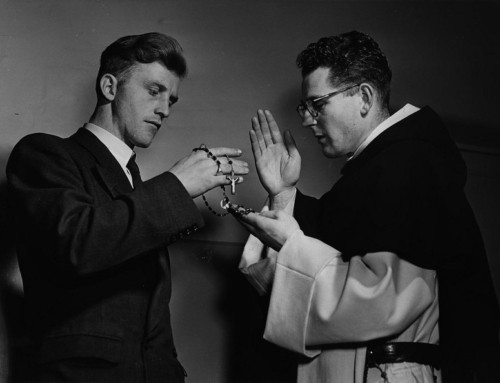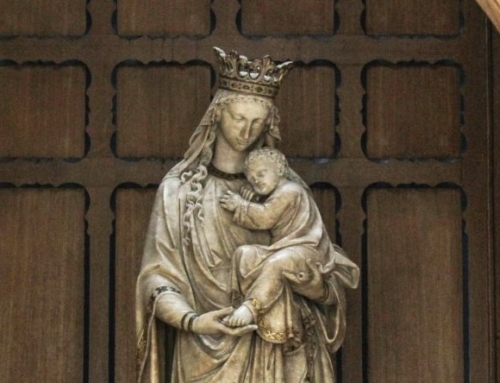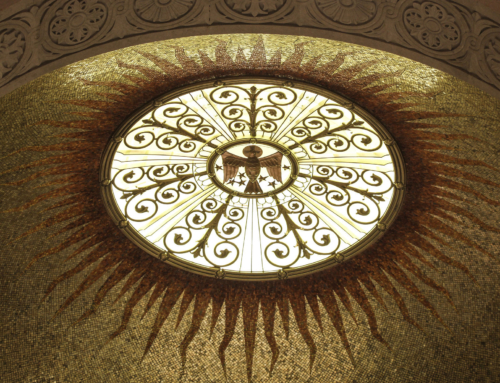Donald Calloway, MIC. Champions of the Rosary: The History and Heroes of a Spiritual Weapon. Stockbridge, MA: Marian Press, 2016.
A Marian priest and alumnus of the Dominican House of Studies is writing to spread zeal for contemplation and apostolic activity through the Rosary. In the introduction to his latest book, Champions of the Rosary: The History and Heroes of a Spiritual Weapon, Father Donald Calloway tells us that the Rosary prompted his initial conversion to the Catholic Faith. He explains that the Rosary is the overlooked “weapon” of heavenly design forged to confront and reverse the unbelief, hedonism, and spiritual callousness of our time (21-24). This book is at once a history, a collection of remarkable testimonies, and a guide to the Rosary—what some reviewers have called a “summa of the Rosary.” In undertaking this project, Calloway follows upon the life work of Bl. Alan de la Roche (1428-1475) and St. Louis Marie de Montfort (1673-1716), outstanding men who revived an “ancient” prayer which was already part of Dominican preaching (65-69, 104-105). Endorsements for the work have not been sparse; this includes praise from some twenty-nine notable Dominicans including the Master of the Order and several bishops. Champions of the Rosary will help bolster one’s appreciation for this fundamental Catholic prayer and promises to encourage clerics and laity in their own capacities to “go and preach” Mary’s Rosary.
Calloway’s first two sections, history and saintly testimony, receive the most attention overall. The historical account works to enlighten the obscure past of this devotion in light of more recent criticism (see below). The hagiographical section then brings to the forefront a litany of personal witnesses (twenty-six “champions of the Rosary” from St. Dominic to the newly-canonized St. Teresa of Calcutta). Let two examples—one historical and one anecdotal—suffice for what is particularly lively and invigorating about Parts One and Two of Calloway’s presentation.
First, Fr. Calloway endeavors to exonerate the “pious tradition” of the Rosary’s heavenly and Dominican origins. Laity and priests alike had proudly passed down the story for ages: the Blessed Virgin Mary came to St. Dominic in a vision with the instructions “go and preach my Psalter,” referring to the Rosary. She then gave him the “sword” needed to vanquish the Incarnation-denying heresy of Albigensianism. Calloway subsequently traces out some strands of skepticism arising from theological polemics in the Church as well as the modern advent of historical-critical research. Citing consistent papal teaching honoring the “pious tradition,” Calloway describes how some scholars nevertheless began to question the historicity of this tradition. Even with a paucity of evidence precisely establishing as fact St. Dominic’s receiving of the Rosary, Calloway points to findings that bolster the plausibility of the centuries-old tale. (One surviving historical piece, the poem Rosarius, pre-dates Bl. Alan de la Roche—who some consider the originator of the pious tradition—by 100 years. Like Bl. Alan’s own message, it assigns St. Dominic with preaching based on the Ave Maria and meditation on the Christian mysteries.) Examining artifacts, gathering studies, and tracing the consistency of the “pious legend,” Calloway is able to call into doubt the hypotheses of such skeptics which lack their own positive proof against the tradition.
Second, Calloway pulls together impressive stories of divine help obtained through the praying of the Rosary up through recent times. One marvelous example is that of Bl. Bartolo Longo (1841-1926). Raised in a devout family, Longo became involved in the nationalist movement in southern Italy and renounced his Catholic faith. At the same time he became fascinated with the occult, even being ordained a satanic priest. Such a lifestyle led him not to freedom, but into deep depression and anxiety. At the recommendation of a friend, he consulted a Dominican priest, who helped Longo to turn away from the occult and find light and deep peace in returning to Christ. Still battling feelings of immense guilt for the damage he had caused as a satanist, one thing gave Bartolo the hope to stay alive: as a Third Order Dominican he began to promote the holy Rosary. His faith bore fruit, and soon he was building hospitals, orphanages, and schools as a Catholic civic reformer. He and his wife witnessed miracles and saw the creation of the famous Our Lady of the Rosary of Pompeii Shrine. Bl. Bartolo’s story of dramatic change is one of many “Rosary victories” recorded in Calloway’s book.
Inasmuch as Champions of the Rosary conveys a wide-sweeping account engaging history and testimony, it should stimulate individuals or groups of the faithful who wish to re-discover the great Catholic devotional prayer. The historical background presented helps one to understand the driving force behind the Rosary’s development. Furthermore, personal accounts of devotees enhance appreciation for such a wonderful instrument. One critical caveat: Calloway’s style conveys his particular piety and he is unapologetic about his conclusions. His presentation lacks some of the detachment and neutrality desirable in historical research. The deeper theological importance of the Rosary sometimes can feel lost amidst Calloway’s efforts to choose sides in various historical debates.
The third and final section of Champions of the Rosary contains practical helps on how to cultivate devotion to the Rosary on both personal and communal levels. It includes scripture-based meditations for the mysteries of the Rosary, sacred art, and information on indulgences and associations dedicated to this spiritual treasure. Although most of the basic tools needed to take up this practice are seminally present, Calloway does not try to explain the dynamics of meditative prayer. This might have proved helpful to those desiring to make deep use of this prayer.
Perhaps no theological all-in-one (a “summa”) worthy of the name can ever be completed. Yet Fr. Calloway has produced a valuable vade mecum for those who would walk and lead others down a well-trodden road. It should inspire Dominicans to “return to the fonts” of their holy Founder’s preaching. It will help all Christians to immerse their lives in the Gospel. There, rooted in the key mysteries of Jesus’ salvation, the Rosary can be in Calloway’s words the “sword” of Gospel victory and a “rose” of personal holiness.
✠
Download a PDF of this review HERE



